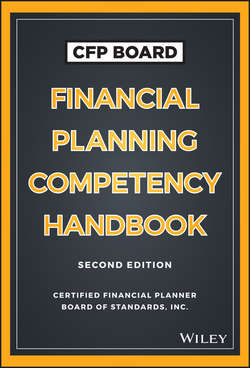Читать книгу CFP Board Financial Planning Competency Handbook - Board CFP - Страница 23
На сайте Литреса книга снята с продажи.
PART One
Introduction
CHAPTER 2
Function, Purpose, and Regulation of Financial Institutions
LEARNING OBJECTIVE
ОглавлениеThe student will be able to:
a. Compare the secondary market institutions and their regulators for each security (stocks, bonds, ETFs, real estate, commodities, and options exchanges) and of primary market institutions (investment banking firms, mutual funds, and hedge funds).
Rationale
Each country regulates securities markets, broker-dealers, insurance professionals, and financial planners differently. Nearly all federal rules, regulations, and laws directed at the oversight of American financial institutions have resulted from abuses observed in the marketplace. Although financial institutions serve a multitude of stakeholders, including governments and firms, federal regulators tend to introduce laws that limit the market power and scope of operations of banks, trust companies, credit unions, insurance companies, and other investment companies when consumers at the household level are harmed. As such, regulation tends to be reactionary, which often results in a time lag after abuses are noted and laws are enacted to counter such abuses.
It is important for financial planners to have a working knowledge of not only how financial institution regulation is created and applied, but also which regulator deals with what type of entity. For example, the Securities and Exchange Commission (SEC), which was created with passage of the Securities Exchange Act of 1934, regulates both secondary market institutions as well as certain primary market firms. The SEC also plays a role in regulating how financial planners interact with consumers.
Regulation of the secondary markets occurs through a number of mechanisms. Financial planners may fall under the enforcement power of state and federal regulators. It is equally likely, however, that a financial planner will have more contact on a regular basis with self-regulatory organizations. Brokers, dealers, and registered representatives typically fall under the rules and regulations of the Financial Industry Regulatory Authority (FINRA). Financial service professionals who deal most often at the primary and secondary market level will interact with numerous self-regulatory organizations, including the Chicago Board Options Exchange (CBOE), Municipal Securities Rulemaking Board (MSRB), National Futures Association (NFA), New York Stock Exchange (NYSE), and the Options Clearing Corporation (OCC). Planners who deal primarily with insurance products will find it useful to be well informed of the National Association of Insurance Commissioners’ (NAIC) rule making.
Related Content Areas Associated with the Learning Objective
■ This learning objective is conceptually related to all aspects of the financial planning process.
■ Financial regulations serve to provide a working framework for financial planners when interacting with clients.
■ The function and purpose of financial institution regulations is closely aligned with business law, financial services requirements, and consumer protection regulations.
